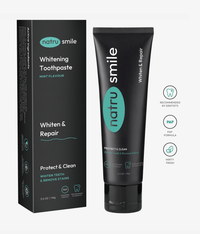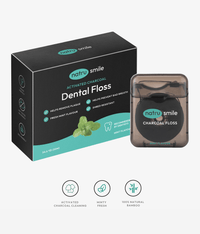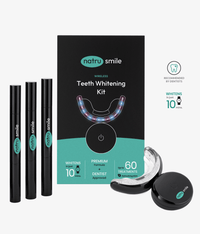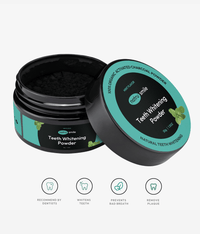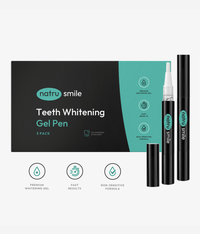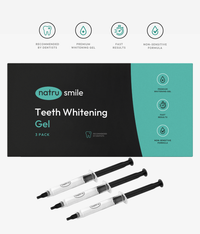
All products are certified by dental expert Dr. Greg Grillo
Whether you bought a few teeth whitening kits over the counter or met with your dentist a few times over the last month, you undoubtedly invested time and money into your new pearly whites.
Teeth whitening results can last as long as 1-3 years, but proper teeth-whitening care is essential to get the most out of your treatment.
From what you eat and drink to your lifestyle choices and home care, there are numerous things you need to account for if you want your investment to pay off long-term.
That's why teeth whitening aftercare is so important—it can make or break the lasting effects of your beautiful smile.
Whether you spend tens, hundreds, or thousands on your last treatment, this article has everything you need to know about what and what not to do after your next teeth whitening session.
10 Things To Do After Teeth Whitening Procedures
If you want to ensure long-term whiteness after a round of teeth whitening, it's essential to understand what foods, drinks, and activities you need to avoid. And knowing what steps you should be taking to look after your teeth is just as important.
Here are ten things to do after a teeth whitening procedure:
1. Cut Out Tobacco Products
Out of all the bad habits that stain teeth, tobacco is probably the worst. There are numerous reasons to cut out tobacco products.
They dramatically increase your risk of heart disease, stroke, and cancer. And in the short term, they can make breathing hard, stain your teeth, and, yes, reduce the results of a whitening procedure.
A significant body of research has proven that smoking, chewing tobacco, and other tobacco products can all cause teeth discoloration—sometimes in as little as just one week.
The reason for this is that the tar and nicotine in tobacco products settle into the pores of your teeth and cause them to yellow underneath the surface. So if you want whiter, brighter teeth for longer, then cutting out tobacco is essential.
Beyond teeth whitening, tobacco products also increase your risks of mouth cancer, gum disease, and bad breath. So even if your teeth don't suffer too much from a tobacco habit, you won't be able to enjoy the benefits of white teeth if you keep the habit up long-term.
2. Avoid Coffee And Tea
If you want to guarantee a whiter smile, a daily coffee or habit won't get you there.
Both tea and coffee contain tannins which are dark, pigmented substances that can penetrate the pores of your teeth, causing staining and discoloration.
We know what you're thinking: "How can I give up my morning cup of tea or coffee?"
The good news is that you don't have to give up your favorite warm beverages completely. But drinking them in moderation can make a big difference when it comes to keeping your teeth white and bright long-term.
There are also a few substitutes to coffee and dark-colored teas you can try:
- Yerba Mate: A caffeinated alternative to tea and coffee, Yerba Mate is a popular Latin American drink made from dried leaves. It's full of antioxidants and doesn't stain your teeth.
- Matcha: Matcha has all the same properties as regular green tea (plus a solid amount of caffeine) but without the tannins that cause discoloration.
- White Tea: White tea contains less tannin than other teas, making it a much better option for those looking to keep their teeth white.
If you decide to continue drinking coffee while getting rid of yellow teeth, the other steps on this list become increasingly important—especially those dealing with good oral hygiene.
3. Keep Your Standard Oral Hygiene Regimen
The ADA recommends brushing your teeth twice daily with fluoride toothpaste and a toothbrush with soft bristles. Beyond this, they recommend flossing and using an antibacterial mouthwash at least once daily.
No matter what kind of teeth whitening option you choose, it's important to remember that it isn't a substitute for brushing and flossing. White teeth do not equal healthy teeth, and regular brushing and flossing will help prevent cavities, gum disease, and other problems.
4. Stay Away From Acidic Foods And Drinks
Most of the worst foods for your teeth are acidic. These kinds of foods are bad for your teeth because they can erode the enamel, which is the thin outer layer that protects our teeth from decay and cavities.
When this protective layer is worn away, our teeth become vulnerable to staining, discoloration, and decay. Acidic foods can also lead to increased sensitivity in your teeth, which can be unpleasant.
Some of the most acidic foods and drinks include:
- Citrus fruits like oranges, grapefruits, and limes
- Carbonated beverages such as soda and energy drinks
- Alcoholic drinks like beer and wine
- Pickles, vinegar, and certain sauces
Avoiding acidic foods in their entirety is practically impossible, so the best way to protect your teeth is by eating them in moderation, being conscientious of how what you eat on a daily basis, and drinking plenty of water in between meals.
5. Avoid Hot And Cold Meals
One of the most common side effects of teeth whitening is tooth sensitivity. One study found post-whitening sensitivity to be a side effect in almost every patient across three different types of whitening. For those with preexisting sensitivity, this can be extremely uncomfortable (and sometimes painful).
Eating hot and cold foods can exacerbate this sensitivity, so it's best to avoid them altogether for the first few days after your whitening procedure.
Examples of hot and cold foods include:
- Ice cream
- Soups
- Ice blended drinks
- Frozen yogurt
Instead, try to stick with room-temperature (or close to room-temperature) meals and snacks, and wait for your food to cool down thoroughly before eating it. You can also omit ice from water, smoothies, and other beverages to avoid discomfort when drinking.
There are also plenty of foods you can eat to whiten your teeth, such as apples, strawberries, and pineapple, which can act as natural teeth polishers. Enjoying these snacks at room temperature can help reduce sensitivity while keeping your teeth white.
6. Consider Whitening Toothpaste
Whitening toothpaste is a type of toothpaste that uses ingredients that help to whiten teeth. It contains whitening agents, such as hydrogen peroxide, carbamide peroxide, sodium tripolyphosphate, and silica compounds. These ingredients work to break down stains on the surface of the teeth, helping them to look brighter.
If you want to maintain the whiteness of your teeth after a dental whitening procedure, using a whitening toothpaste can sometimes be beneficial, especially when keeping your teeth white long-term.
However, whitening toothpaste is also abrasive, so it should not be used for more than four weeks in succession. And if the abrasion causes additional tooth sensitivity, it may not be worth the small change in whiteness.
Research also demonstrates that over-whitening can actually damage your tooth enamel, so your dentist may advise against using this kind of toothpaste altogether.
7. Use Straws To Avoid Staining
When fluids come into contact with your mouth, they don't stain your mouth immediately, thanks to your body's natural protective mechanisms.
But when these fluids linger on the surface of your teeth for an extended period of time, they can eventually cause discoloration and staining. And with long-term exposure, your teeth will be more prone to staining and enamel erosion from fluids like coffee, tea, and soda.
To avoid this type of staining, try using a straw when drinking beverages like coffee, tea, juices, and soda. The straw will help to keep the beverage away from your teeth until you can rinse your mouth out with water.
Especially since acidic drinks can slowly cause white spots on teeth (among other problems), it’s worth making this simple change to your regular habit.
8. Go For Regular Cleanings And Checkups
After an in-office whitening session, your dentist might suggest a follow-up appointment. But the buck shouldn't stop there—regular checkups are still crucial for keeping your teeth healthy and white.
It's ideal to visit your dentist every six months for a professional cleaning and checkup. Dental cleanings help to remove plaque and tartar that would otherwise cause staining, discoloration, and decay. And during your checkup, the dentist can look for signs of any potential oral health issues.
Dental appointments can be a hassle, but it's important to remind yourself that they don't take long. And if you're in the dentist's chair, you can ask them any questions you may have about your teeth whitening aftercare procedures and oral health routine.
9. Limit Alcohol Consumption
Drinking is tough on your body for a number of reasons, but your oral health suffers from it significantly.
- Drinking alcohol can lead to dry mouth and decreased saliva production, making it more difficult for the mouth to defend against bacteria.
- Alcohol can irritate the soft tissues in the mouth and increase inflammation in existing dental issues.
- Excessive and/or regular drinking of alcohol can lead to faster wear of your teeth, leading to decay or damage.
- Consuming alcohol increases the risk of developing oral cancer, as well as cancers of other areas.
- Alcoholic beverages often contain a high amount of sugar, which increases bacterial growth in the mouth and leads to tooth decay.
After a night out drinking, it's also common to fall asleep without brushing your teeth, leading to more staining on the surface of the teeth.
Therefore, it's best to limit your alcohol consumption and practice good oral hygiene when you do drink.
10. Don't Use Too Many Whitening Products
It's easy to get obsessed with your whiter smile and think that more is better when it comes to whitening products. But using too many whitening products can actually be detrimental to your teeth and gums.
Teeth whitening is generally safe, but only when used in recommended amounts or doses. This means that if you use products with excessive levels of active ingredients, it can lead to gum irritation, tooth sensitivity, enamel erosion, and eventual damage.
Using a home-based system too often or for extended periods of time is one of the main culprits of this. Without professional dental supervision or advice, many people use their at-home teeth whitening products too often or for too long, leading to dental issues.
It's best to use whitening products only as recommended by your dentist, or to follow the instructions on over-the-counter products to a tee.
The Bottom Line
At-home and in-office teeth whitening are both safe and effective ways to brighten your smile. But proper aftercare and maintenance are critical for keeping your pearly whites looking their best.
By following the steps listed above, you can ensure that your teeth stay healthy and white long after your whitening session has ended. And with regular checkups, you can keep tabs on your oral health and make sure that your teeth stay in tip-top shape.
Remember that having a healthy smile is just as important as having a beautiful one! With the right aftercare habits, you can achieve both easily.


